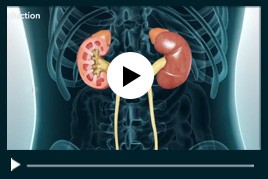Adrenalectomy
Adrenal glands are two triangle-shaped glands located above the kidneys, which secrete hormones that control your metabolism, blood pressure, chemical levels in blood and usage of glucose. Laparoscopic adrenalectomy is a minimally invasive procedure used to remove an adrenal gland affected with a tumour.
Laparoscopic adrenalectomy is performed under general anaesthesia. Your surgeon makes 3 to 4 small incisions (1/4 to ½ inches) in your abdomen. A laparoscope (small tube with camera attached at one end) is inserted into one of the incisions to help your surgeon view your internal organs and perform the surgery. Surgical instruments are inserted into the other incisions to separate the adrenal gland from its connections and dissect it away from the kidney. The gland is placed in a bag and removed through one of the incisions. All the incisions are then closed. Laparoscopic adrenalectomy requires a very short hospital stay and causes less pain compared to the traditional open procedure. Like all surgeries, laparoscopic adrenalectomy may be associated with a few complications such as bleeding, injury to the surrounding organs, high blood pressure, blood clots and infection.
Adrenal surgery involves removal of one or both adrenal glands. The adrenal glands are paired endocrine glands located above each kidney. The surgical procedure of adrenal gland removal is known as adrenalectomy and is indicated in patients with benign or malignant tumour like mass within the adrenal glands. Adrenalectomy can be performed either with laparoscopic technique or open surgery.
Laparoscopic adrenalectomy
Laparoscopic adrenalectomy is usually indicated for non-cancerous (benign) adrenal tumours. This technique uses small incisions instead of a large incision. A small incision is made in the flank (side of the body, between the ribs and the hip) through which a laparoscope (a thin telescope like instrument) is inserted. The laparoscope is attached to a tiny video camera which enables the surgeon to visualize an enlarged view of the site of operation on the television monitor. Carbon dioxide gas is introduced into the abdominal cavity so as to inflate it and give a clear view of the operating area. Further, two or three small incisions are made through which surgical instruments are inserted to perform the adrenalectomy procedure. The skin incisions will be sutured and covered with a surgical dressing.
The advantages of laparoscopic adrenalectomy include less postoperative pain, a shorter hospitalization period, minimal scar, reduced chronic pain from nerve injury, minimal risk of developing hernia, and a fast recovery with a much quicker return to normal activity.
Open Adrenalectomy
When performing an open adrenalectomy your surgeon may choose from three different approaches: anterior, posterior, and thoracoabdominal.
The anterior approach is most commonly used and involves a vertical incision made in the middle of the abdomen or a diagonal incision just under the ribcage. The surrounding structures are moved apart to expose the adrenal glands. As this approach provides better exposure, it is ideal for large sized adrenal tumours particularly if a malignant tumour is suspected and removal of surrounding organs invaded by cancer needs to be done.
In the posterior approach, a curved incision is made on the side of the gland to be removed. The surrounding muscles are moved aside using retractors. During this approach a part of the lowest rib may also be removed. This approach does not provide a wider and complete view of the surrounding structures as with the anterior approach. Hence it is not useful in conditions with larger tumours and possibility of malignancy which may require removal of additional organs.
Thoracoabdominal approach is considered when the tumours are very large and invade the surrounding organs or veins that drain the adrenal gland. In this technique a large incision is made which extends through the abdomen and the chest to provide wide exposure of the area. This approach may cause increased postoperative pain and lung complications.
The risks of complications are higher with open surgery compared to the laparoscopic surgical procedure. Possible complications of adrenal surgery include lung problems, wound infection, bleeding, scarring, formation of blood clots in the leg veins which may travel to lungs, adrenal insufficiency (inability to produce enough cortisol), and damage to blood vessels and adjacent organs (spleen, liver, pancreas).

 Menu
Menu




